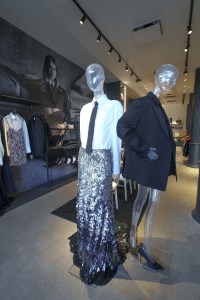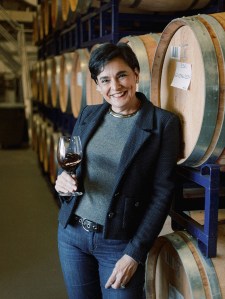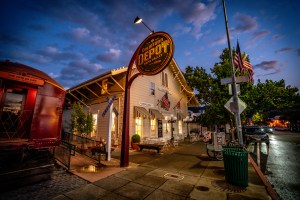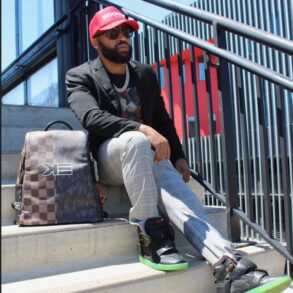“Stun-ning,” says Mimi DeBlasio, a former wardrobe stylist who is the co-owner of the cult Scarecrow Wine, watching her friend emerge from the dressing room in a $4,500 Valentino cocktail dress at Elyse Walker‘s new store in the Napa Valley’s St. Helena, Calif.
Walker is hosting a cocktail party to celebrate the brand’s Black Tie eveningwear collection — which popped up at only one other store in the country, Bergdorf Goodman — then having a dinner at her home with an appropriately Valentino red table-scape and food by “Hell’s Kitchen” winner Christina Machamer.
Stylish women, some who flew in for the event, are snapping up minidresses and bags for the many occasions that happen in the California wine region 50 miles northeast of San Francisco that has some of the world’s most luxurious hospitality, food and beverage offerings but has been “starved for fashion,” as Colgin Cellars doyenne Ann Colgin puts it.
“Elyse has figured out that even though this is an agricultural market, we’re all businesswomen, we travel a lot, and we don’t always have time to put together outfits. She has a Valentino if you need it, but if you need an up-to-date jean, sweater and boot, and maybe you aren’t sure how to put it together, they are experts at it,” says Leslie Frank, a broadcast journalist turned founder of Frank Family Vineyards, wearing a Valentino Iconographe cape.
Luxury groups LVMH Moët Hennessy Louis Vuitton and Chanel have been investing in Napa Valley vineyards since the 1970s. And while you won’t find Dioriviera or Chanel pop-ups attached to tasting rooms — at least not yet — waning wine sales, particularly among Millennials, are forcing the area of 400-plus wineries to look at broadening offerings to attract tourists.
Walker is one of a number of pandemic-era transplants bringing new ideas to the destination — comprised of small towns Napa, Yountville, St. Helena and Calistoga — which has a lot in common with secondary markets that have become retail magnets in recent years, such as Aspen, Montecito and the Hamptons.
All of which begs the question: Could Napa Valley become a fashion destination?
“I’ve talked many times about Dolce & Gabbana doing Alta Moda in the Napa Valley. Their Asian clients could get there easily and there are so many locations that are a fit for a backdrop,” says Alexis Swanson Traina, who for many years served as creative director of her family’s Swanson Vineyards in St. Helena before launching HiNote, an app that helps people create personalized digital communications.
In September, Traina’s sister Veronica Swanson Beard took over Elyse Walker’s temporary space just off Main Street in St. Helena. “The Veronica Beard uniform is a blazer and jeans…you can wear that with flats if you’re a marketing executive or a winemaker in Napa Valley, then throw on your heels to go to dinner at French Laundry,” the designer says of the offerings in Veronica Beard’s sixth California store.
Napa Valley has long been a luxury travel destination, with numerous high-end hotels including the classic Meadowood, now fully restored after the devastating 2020 Glass Fire; a Four Seasons, and three Auberge properties. The newest is Auberge Stanly Ranch on the southern edge of the valley, which opened in April 2022 with a new focus on retail: a Fifth Avenue Club offering personal shopping from Saks Fifth Avenue, including same-day delivery for those who might prefer to shop from afar than visit troubled downtown San Francisco.

Veronica Beard opened its sixth California store in the Napa Valley.
“San Francisco is trying to find its footing so a lot of people are also using day tripping as a great opportunity,” says Traina, who in 2017 published the guidebook “From Napa With Love.”
“There are so many things going on. The Slanted Door, which is Charles Pham’s extraordinary French Vietnamese restaurant from San Francisco, just opened in Napa….Capo from Santa Monica is coming. Elyse’s store was eye-opening to me, she put such care into it. I’m desperate to see Kemo Sabe show up,” she says of the high-end Western wear retailer based in Aspen that has five stores in resort towns.
“Napa Valley survived two massive fires and the pandemic, and it’s taken time to reignite a way of living. But at the same time new people are coming in, bringing fresh ideas. Main Street in downtown Napa was dead and now there’s hardly any space not under construction and ready to open,” she says of the momentum, while cautioning that Napa Valley is just 26 miles long and 3 miles wide, and is an agricultural preserve with many use restrictions.
Walker, who owns six stores in California and New York, never thought she’d find a business opportunity when she started spending time at her home in St. Helena during the pandemic, only to move to the area permanently. She now commutes to her office in Los Angeles twice a month.

Elyse Walker Napa hosted the Valentino Black Tie collection installation in October.
“It’s farmland, I was coming here to relax,” she says, adding that when she began doing some styling and shopping for local friends during the height of COVID-19, it solidified that there was an untapped market. “It reminded me of the Pacific Palisades when I started there,” she says of the small town community in L.A. where she started 24 years ago.
The retailer has brought Celine bags, Rosetta Getty blazers and Saint Laurent blouses to a historic 1800s building on St. Helena’s Main Street, where shopping has until now leaned more toward the low-key and traditional, as evidenced by the 100-plus-year-old Model Bakery, Mario’s from Seattle for men’s haberdashery, and Sportago for Patagonia fleece.
Luxury brands have taken notice; Bottega Veneta approached Walker for an exclusive art installation, then Valentino came calling. “I was surprised to see a lot of people flew in for the event but also locals who shop Valentino with Elyse. It was good to see we have clientele here that we weren’t necessarily aware of,” says Karoline Auger, brand manager for Valentino.
Other European luxury players have long invested in the local wine industry, but not brought fashion with them per se.
In 1973, LVMH’s Moët Hennessy opened Chandon, the first French-owned sparkling wine producer in Napa Valley, which has just renovated its Yountville Estate for the 50th anniversary with a contemporary and sustainable design with soothing earth tones, a new restaurant and stunning outdoor venues with private patios, nooks and cabanas, creating a day club atmosphere.

Chandon’s 50th anniversary renovation creates a day-club-like atmosphere on the grounds.
The restaurant at Chandon launched Napa Valley’s fine dining scene, opening in 1977, and it was the first winery to receive a Michelin star.
“There was a moment in time when it became a frat house, we acknowledged the reality…the piece on wine education got lost, and now we’ve rebalanced that experience,” says Chandon’s marketing manager Mitalee Gupte of updating the experience, touting the new chef’s garden and culinary journeys.
Chandon will soon debut a new retail concept on-site with tableware and home and hearth accessories selected by sustainable marketplace Powered by People, but no LVMH fashion merchandise.
You won’t find any at the three other Moët Hennessy-owned vineyards, either.
“If anything they are bringing us some of their private clients, but we don’t talk a lot about being owned by them. It’s out there but when you come here, you don’t see any Louis Vuitton,” says Elizabeth Phelps Neuman, chief executive officer of Joseph Phelps Vineyards. The St. Helena winery with a tasting terrace that has a postcard view of the valley was acquired by LVMH in 2022.

A view of the valley from the terrace at Joseph Phelps Vineyards in St. Helena, Calif.
Briana Forgie
“This is the original building my grandfather built in 1974 and when the chief executive officer of Moët Hennessy Philippe Schaus came the day the acquisition closed, he said, ‘I think we could do a little modernizing and put some comfortable furniture in.’ And he’s made some great changes,’” she says during a tour of the indoor space that reopened in September after a renovation by Nobu go-to Montalba Architects.
“We need more brand awareness and amplification and they know how to do that,” she says of selling to LVMH. “I’m proud that they came to us.”
The vineyard produces one of the most iconic American wines, Insignia, California’s first proprietary Bordeaux blend, which has been served for decades to presidents and heads of states, including former U.S. President Barack Obama and French President Emmanuel Macron.
On the subject of fashion, Neuman says her grandfather was a bon vivant in his day. “He got his pajamas from Harrods and had them pressed every day,” she remembers, adding that he wore them out to dinner, too. “That’s Napa style, if you want to go glam you go glam, if you want to wear pajamas, you wear pajamas.”
In 2015, Chanel owners Alain and Gerard Wertheimer purchased the sustainable St. Supéry Estate Vineyards and Winery in St. Helena, adding to their two properties in Bordeaux. At the property’s historic Queen Anne Atkinson House, built in 1882 and now on the National Historical Register, a tome about Chanel sits on the coffee table next to Napa Valley history books.
“We have done the remodel of part of the Atkinson house and a lot of investment in the cellar, and they’ve been hugely supportive of us doing more each year,” says Emma Swain, St. Supéry’s CEO, of the relationship with the brand. She’s wearing Chanel boots during a tour of the French-style gardens and winery which produces Estate-grown, certified Napa Green wines, including a terrific 2022 Dollarhide Sauvignon Blanc fermented in cold concrete.
“We work together on our global strategy, particularly improving quality, improving experience, our giving and philanthropy. And we share a lot of ideas on sustainability with each other. They are very involved on a global level and we are on a local level,” says Swain, adding that St. Supéry also collaborates with Chanel on raising money for the area, for clients’ causes, and hosting employee events.
Chanel’s nearest boutique is in San Francisco, however.

St. Supéry chief executive officer Emma Swain.
“I think there is a desire to have more activities other than wine. We have the Agricultural Preserve and we can’t develop other activities within that,” she says of the first and only zoning legislation of its kind in the U.S., passed in 1968. “But where we can do more things in town, it’s great. You can’t drink wine all day.”
Napa Valley impresario Jean-Charles Boisset is one of a new generation trying to create more experiences while celebrating the area’s history. The native of France moved to the Bay Area in 1991 to lead his family’s wine import business and acquired several vineyards, including California’s oldest, Buena Vista, in 2011 and Elizabeth Spencer in 2021, which now houses the Kathleen Thomas Hill Kitchen Memories collection of culinary relics.
Married to Gina Gallo, the third-generation face of the family behind the world’s largest wine producer by volume, E & J Gallo, Boisset has a flair for branding and has produced jewelry with Swarovski, crystal with Baccarat, fragrance with Ex Nihilo and hosted events with Neiman Marcus. His De Lalisse Champère sparkling wine has been featured in Netflix’s “Emily in Paris.”
Boisset has several F&B and hospitality projects in his portfolio, including the historic Oakville Grocery with its Napa Wine History Museum, and the Calistoga Depot, where in February he’s opening a distillery with its own collection of spirits, and creating an “adult beverage experience” across 2 acres and six vintage train cars offering everything from whiskey blending to tequila and wine tasting, Champagne and caviar pairing and wine-infused chocolate.
He’s also setting up a wellness boutique, tapping into Calistoga’s heritage of hot springs and health, and is bullish on the future of the town, which has 800 hotel rooms, including a Rosewood coming in, and connects to the walking and biking Vine Trail currently under construction to connect the entire Napa Valley.

Calistoga Depot
Dylan Elliott
The region now has a lot of activities beyond wine and food, Boisset says. “BottleRock Napa Valley is an incredible event in May. We are very active with Festival Napa Valley in July, which is bringing the best classical music singers like [Andrea] Bocelli up here….It’s wine and food, music, art and a younger generation who want to come and play and make wine,” he says, adding a plug for another project that will let people purchase a few rows of one of his vineyards.
The ultimate experience could well be a luxury brand fashion show in one of those vineyards, of course.
“I see it coming,” he says.
“There is no shortage of taste,” says Traina.
“So many people have moved here over the last 25 years from other areas, and while most of them travel a lot, go to art exhibitions in other places, and shop around the world, they want their community to be elevated,” says Colgin, the art collector, philanthropist and founder of top-tier Colgin Cellars who sold a 60 percent stake in her business to LVMH titan Bernard Arnault after bonding with him over modern art.
“Luxury branding, I’m not sure St. Helena is really ready, but this mix of what Elyse has is a niche for this area,” she adds.
What about a Dior runway show among the vines at Colgin? “Well,” she says, “that would be fantastic.”
This post was originally published on this site be sure to check out more of their content.








